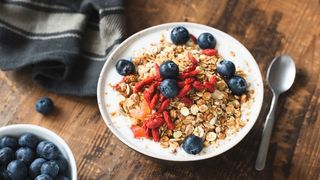What is the DASH diet?

- at home
- References

If you have been researching different diets lately, you have come across the DASH diet, and you may be wondering what it consists of. The DASH diet, first introduced in 1997, means "dietary approaches to stop hypertension" (also known as high blood pressure).
Hypertension affects about half of all Americans and is defined by the CDC as systolic blood pressure greater than 130 mmHg or diastolic blood pressure greater than 80 mmHg. If left untreated, high blood pressure can damage several organs throughout the body and cause a heart attack or stroke.
The good news is that there are several ways to reduce high blood pressure. While it can certainly help to invest in one of the best water bottles and increase your fluid intake, the DASH diet offers an excellent diet-based way to help lower high blood pressure without drastic changes in the food you eat.
By focusing on reducing the amount of sodium consumed by encouraging people to eat all foods, the DASH diet helps people to reduce their intake of red meat and processed foods (high in sodium) and their fiber and increase mineral intake. foods such as fruits and vegetables.
Is the DASH diet suitable for everyone? How does it work? And are there any side effects to not following it? Read on to find out.
What is the DASH diet?
The DASH diet aims to reduce the consumption of red meat and highly processed foods high in salt and sugar, and to increase potassium, magnesium and calcium. Potassium, magnesium and calcium are important minerals in the regulation of blood pressure because they play a role in relaxing and narrowing blood vessels. In addition, potassium has a cleansing effect on sodium in the body, so according to the American Heart Association, the more potassium you eat, the more sodium you lose in your urine.
A study in the Journal of the American College of Cardiology showed that sodium reduction may be beneficial for people with prehypertension and stage 1 (high blood pressure). Research has shown that the DASH diet can be used as an intervention method to help reduce high blood pressure and prevent the development of secondary health problems in people with high blood pressure.
To learn more about blood pressure and how our vascular system works, read our guide to blood vessels and veins: Facts about our blood vessels.

What to eat in the DASH diet
Dietitian, dietitian and nutrition consultant Laura Clark explains the main features of the DASH diet. "It is a diet rich in fruits, vegetables, whole grains, fish, poultry, beans, legumes, nuts, seeds and low-fat dairy products," he says. "The DASH diet focuses on reducing meat and processed foods that are high in salt and sugar. Combine salt reduction with more food intake, which helps lower blood pressure and protect our arteries. There are no absolute restrictions on this diet - it's about achieving a better balance with foods that have been proven to help, and reducing salt intake to less than 6 grams a day. "
As recommended by the DASH diet, increasing your intake of fruits, vegetables and whole grains will help increase your dietary fiber intake, which will give you a feeling of satiety and satiety while eating. Hunger and dissatisfaction often lead to a diet, so it is important to help keep hunger low and motivation high.

A study by the Journal of Nutrition on the role of fiber in weight loss shows that a high-fiber diet can help obese people follow a calorie-restricted diet. Since obesity is a common condition associated with hypertension, losing total weight can help treat both symptoms and reduce stress on your cardiovascular system.
If you are looking for another healthy alternative to the DASH diet, you can look at the Mediterranean diet .
Potential benefits of the DASH diet
According to the CDC , only 1 in 24 adults with hypertension (24%) is under control, a staggering number given the number of people with the disease in the United States. Dietary changes such as following the DASH diet can help keep the condition under control.
Clark explains that the DASH diet has several applications, although it was started as a diet to help people with high blood pressure. "It was originally designed to lower blood pressure, and also has other cardiovascular health benefits, and its richness in cardioprotective foods such as fiber, calcium, potassium and magnesium reduces the risk of stroke, heart attack and improves overall cardiovascular health," he says. It's a healthy way to eat for the whole family. "
Reducing the consumption of processed foods and switching to more complete foods can help improve your overall health, as it is often associated with a reduction in dietary sodium, saturated fat and sugar, which can contribute to the development of high blood pressure or related conditions.
References
Hypertension Facts | cdc.gov. (21 September 2021). Centers for Disease Control and Prevention. Retrieved April 22, 2022, from https://www.cdc.gov/bloodpression/facts.htm#:%7E:text=Nearly%20half%20of%20adults%20in , are% 20take% 20medication% 20for% 20hypertension.
How Potassium Can Help Manage High Blood Pressure (April 22, 2022). Www.Heart.Org. 22 April 2022 https://www.heart.org/en/health-topics/high-blood-pression/changes-you-can-make-to-manage-high-blood-pression/how- potassium - Extract from. can-help-control-high-flood-pressure #:% 7E: text = The% 20plus% 20calcium% 20your% 20 meals, 80% 20chi% 20è% 20reverted% 20health .
Juraschek, SP, Miller, ER, Weaver, CM, & Appel, LJ (2017). Effects of sodium reduction and DASH diet on basal blood pressure. Journal of the American College of Cardiology, 70 (23), 2841-2848. https://doi.org/10.1016/j.jacc.2017.10.011
Miketinas, DC, Bray, GA, Bale, RA, Ryan, DH, Sacks, FM and Champagne, CM (2019). Fiber intake predicts weight loss and adherence to diet in adults using low-calorie diets: the PUNDS Lost study. Journal of Nutrition, 149 (10), 1742-1748. https://doi.org/10.1093/jn/nxz117

Lou Mudge is a British Vanna medical writer for Future PLC. He has a creative writing degree from Bath Spa University and his work has been featured on Live Science, Tom's Guide, Fit & Well, Coach, T3 and Tech Radar. He regularly writes about health and fitness topics such as air quality, gut health, diet and nutrition, and their impact on our lives.
He worked on a chemical research project at Bath University and co-authored a short book with the education department of Bath Spa University.